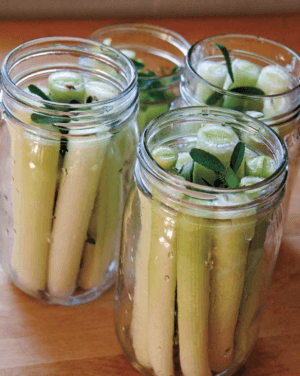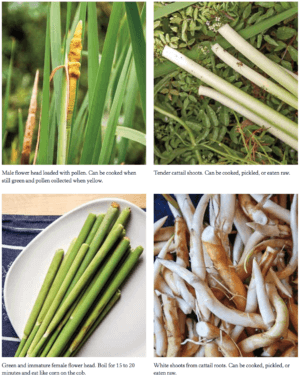Foraging and Cooking Cattails
Author Pascal Baudar is taking the notion of foraging and incorporating wild ingredients into food to a new level in his book The New Wildcrafted Cuisine, as in the following tips on foraging and cooking cattails.
In his extraordinary book, Baudar deeply explores the flavors of local terroir, combining the research and knowledge of plants and landscape that chefs often lack with the fascinating and innovative techniques of a master food preserver and self-described “culinary alchemist.” He views the terrain as his culinary playground, full of wild plants and other edible and delicious foods (even insects) that once were gathered and used by native peoples but that have only recently begun to be re-explored and appreciated. In the following excerpt, Baudar explains how to forage, and eat, cattails. Springtime and early summer are the best times to seek out this nutritious, and delicious, plant.
The following excerpt is from The New Wildcrafted Cuisine by Pascal Baudar. It has been adapted for the web.
(Photos courtesy of Pascal Baudar unless otherwise noted.)
Cattail (Typha latifolia) is one of the most versatile plants growing in the wild and can be found pretty much anywhere in the United States.
This plant loves water and can be found growing on the edge of lakes, in streams, marshes, swamps, or in very wet soil. It is usually 5 to 8 feet tall once mature. It is easily recognizable with its stiff, flat leaf blades. In the center you will find an erect, rounded stem reaching up to 6 or 7 feet (around 2 meters) in height. At the end of the stem, the flower head forms a cylinder densely packed with tiny male flowers in the top cluster and tiny female flowers in the bottom cluster. When the male cluster is loaded with pollen it looks bright yellow. The pollen is extremely easy to forage in large quantity.
Picked at the right time, the bottom of the stem can be eaten either raw or cooked. It is extremely important to make sure the water is not polluted; don’t pick cattails where there is lot of human activity, horse riding, and so forth, as there may be harmful bacteria or even parasites in the water.
The bottom end of the stem looks very much like a leek. Using a knife, cut the lower stem (around 10 to 12 inches [20 to 25 cm]) and place it in your foraging bag. Once you’re back home, clean the stems thoroughly; I usually use three changes of water to clean the stems. The inside of the stem is very tender—you may need to remove a layer or two to get to the tender stalk.
You will need to get your hands dirty if you want to collect the rhizomes, which are loaded with starch. In spring, I’m always interested in collecting the very young white shoots coming out of the root; those shoots are quite tender.
The season to forage cattail shoots is usually early spring, while the pollen is harvested in May or June. In Southern California we sometimes have both a fall and spring season.
Aside from food uses, native peoples used the long, flat leaves for making hats, roofing, sandals, and woven baskets. The dried leaves were even twisted to make dolls and various children’s toys.
From a medical perspective, the crushed roots can be applied to burns, bruises, or cuts to promote healing and soothe pain.
Foraging and Culinary Tips for Cattails
 Roots
Roots
The roots are usually found a few inches belowground. Harvesting them can be a dirty, messy job. You often have to get into the mud, dig with your hands, and pull them out. The first time I foraged them I was a bit baffled by the fact that theyíre very fibrous and spongy. I was expecting them to be somewhat tender. Cattail root is not something you can eat or cook as is. They are loaded with starch, which must be extracted to make flour by chopping the roots into small pieces and grinding them in water. Another option is to scrape the starchy substance with a knife. The resulting starchy juice can be used in primitive bread recipes, or the starch can be collected for future use after settling at the bottom of a container and dehydrated.
The true delicacy is the young and tender white shoots coming out of the roots in spring. Forage them carefully, as they break easily. You can cook or pickle them. At Melisse restaurant they are cut in thick slices and cooked like scallops with the appropriate sauce.
Shoots
The bottom end of cattail stalks is my favorite forage. You can eat it raw or cooked. It looks very much like a leek, and you can cook them as such. It’s quite awesome sautéed, but more often than not we cut it in thin slices and use them raw in salads.
The flavor is similar to a cucumber with a nutty accent. It’s delicious. I usually pull back the two main outer leaves, then grab the other inner leaves and pull gently. It is best to do this when the plant is growing in water. Depending on the season, location, and age of the plant, the first 4 to 10 inches are tender and edible.
Flowers
Around May or June (and again in the fall here in Southern California), the cattail pollen can be collected from the top cluster (male flower part) by shaking it into a bag. This pollen can be used as a very colorful yellow flour in bread and pastries. In a good location, I’ve been able to collect 2 or 3 cups per hour.
Usually there is a decent amount of fluffy material mixed with the pollen. Remove it by straining the flour using a regular kitchen strainer.
Before placing the pollen in a jar or paper bag, you need to dehydrate it. I place it on a large flat plate in the dehydrator for a couple of hours; you can also use your oven at the lowest temperature setting, leaving the door open an inch or two. Failure to remove the moisture may result in your pollen molding and going bad.
The still-young and green bottom cluster (female flower part) can be eaten like corn on the cob after 15 to 20 minutes of boiling. Just add some butter, salt, and pepper and you have a delicious treat. The immature and still-green male flower can also be boiled for 10 to 15 minutes and is very nice sautéed.

Pickled Cattail Shoots
Pickled Cattail Shoots
Ingredients for each jar
- 8 medium-sized cattail shoots
- 1/4 California bay leaf (or 1/2 regular bay leaf)
- 2 small chili pods – they’re optional, but I like a little spicy kick (your choice of chili will determine how much kick you have – I usually use dried whole Japanese chili peppers)
- teaspoon (6 g) sea salt
Pickling solution
- 3 cups (709 ml) apple cider vinegar (5% acidity)
- 2 cups (473 ml) sweet white wine or white elderberry wine (from Mexican elder)
Procedure
- Clean your cattail shoots thoroughly and keep the tenderest parts, usually the first 5 inches or so. Remove the outer layers if necessary.
- Clean the jars thoroughly, then place the shoots and other ingredients in them. I keep the jars somewhat hot by standing them in a couple of inches of hot water. Thatís because Iíve had a couple of (cold) jars crack when pouring the hot pickling solution in them.
- Follow Basic Water Bath Canning (on page 38 of the book). Bring the pickling solution to a boil and pour it slowly into the hot jars, leaving 1/2 inch headspace. Remove any air bubbles with a clean spoon or knife. Your cattail shoots will have a tendency to float; you will need to push them down when putting the lids on the jars.
- Place in the refrigerator and enjoy after a couple of weeks. If you want to can them using the water bath method, process for 25 minutes in boiling water.

 Roots
Roots